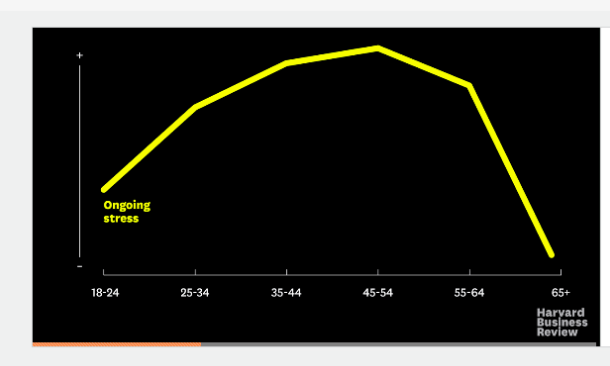According to the Harvard Business Review researchers (as seen in graph below), there was a significant amount of stress that increased among thousands of test studies in their late twenties, or from the age of around 25. And even though the stress levels did keep rising through their 30s and 40s, the time in which those levels increased was significantly shorter than the rapid increase of stress of the quarter-life crisis time.
This graph indicates the steep incline of stress as it hits around the 25–34 mark. And although it shows clearly that the stress levels continue to rise before they again fall around the late 50s, the graph indicates that the incline is slower everywhere else but the late 20s.
Negative Feelings and Wandering Mind
Negative feelings decrease in your late 30s, signalling that our 30s is when we learn to deal with stress and cope in a positive way. Positive feelings nearly hit absolute bottom at the quarter-life mark, but afterward, they begin to constantly increase. General satisfaction with life also starts low in your 20s but increases from thereon in, leading psychologists to believe that the late twenties is the time to understand how we recognize and deal with our emotions in the best ways.
The Five Phases of a Quarter-Life Crisis
According to scientists there are five phases of a quarter-life crisis. These are: Phase 1: Feeling as if you are living your life automatically and are powerless to stop it or regain control. You might feel trapped or unable to know which way to move or how you got where you are. Phase 2: A distinct creeping feeling that you want to “get out” or run for the hills and somehow change your life. Phase 3: Taking time out suddenly to explore the world, explore yourself, or “find yourself” as they say. Suddenly making flip decisions to leave whatever it is you are doing at that moment and to embark on a journey that helps you understand the crisis better. Phase 4: Putting your life back together in a way that you actually want, rebuilding it in a new way. Phase 5: Developing fundamental ways to understand and perform better your new and developed choices. Having new commitments that better represent you and the things you really want. 80% of people who went through such a crisis said that they came out the other side better. The quarter-life crisis can be the most astounding and profound time of your life in terms of making your life into what you want it to be — and trimming the fat from all unnecessary areas. People deal with pain in a myriad of ways, but we should always use these times to better understand ourselves. How are we feeling? Why do we feel this way? What is within our own control? What is NOT in our control? How do we feel about ourselves? How does what we put out affect what we receive? These are the things we should be thinking about when we are dealing with our own happiness. And part of our happiness is determined by the autonomy that we have over our own choices and our own life. We must be the masters of our own destiny, and we do so by being inherently honest with ourselves and by truly listening to who we really are.
